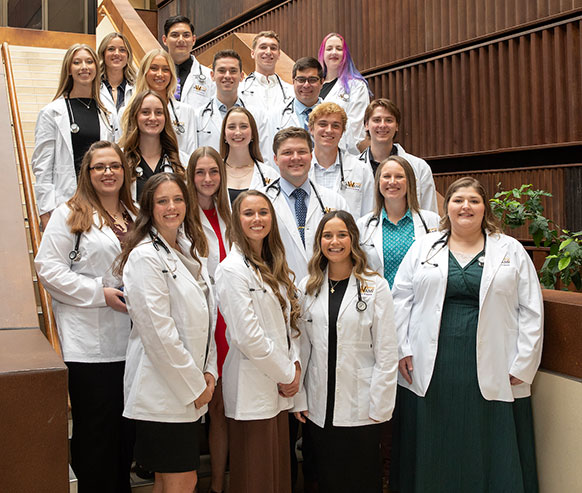
The WWAMI Medical Education Program at the University of Wyoming recently welcomed its 29th entering class at its annual stethoscope ceremony. During the ceremony, 20 new medical students from across Wyoming were presented with stethoscopes and white coats. From left are: front row, Elizabeth Girling, Ali Lange, Brooklyn Prince and Linsey Lancaster; second row, Gabrielle Reimann, Rachael Harrower, Easton Couch and Cherol Minton; third row, Zoe Robison, Maggie Kuehl, Logan Jensen and Daniel Shumway; fourth row, Erica Farris, Alexis King, Jordan Moore and Dalton Nichols; fifth row (top), Annabel Hagen, Carlos Garcia, Winston Littlejohn and Samantha Johnson. (Brian Harrington Photo)
The WWAMI Medical Education Program at the University of Wyoming recently welcomed its 29th entering class at its annual stethoscope ceremony.
A stethoscope ceremony, in which 20 new medical students from across Wyoming were presented with stethoscopes and white coats, marked their start in WWAMI (Washington, Wyoming, Alaska, Montana and Idaho) at UW through the University of Washington School of Medicine. The event was sponsored and hosted by Ivinson Memorial Hospital in Laramie.
The students’ white coats were presented by local Wyoming doctors who mentor medical students throughout all four years of their WWAMI education. The students were then presented stethoscopes and diagnostic kits by WWAMI alumni Aaron Spurlock and Kim Westbrook. The stethoscopes were provided by the University of Washington School of Medicine Alumni Association and the diagnostic kits by Ivinson Memorial Hospital.
Dr. Dan Radosevich, WWAMI clinical assistant professor, spoke to the medical students during the ceremony and will lead their clinical education over the next 18 months.
“Now that the students have received their physical examination equipment (at the stethoscope ceremony), the WWAMI clinical faculty is looking forward to teaching the students how to talk with and examine patients,” Radosevich says. “Now is the time for the students to learn how to think, act, feel and comport themselves like physicians.”
For the students, the event held deep significance in their journey toward becoming physicians.
“The stethoscope ceremony was a deeply meaningful milestone, one we have all envisioned and worked toward for years,” says Brooklyn Prince, a first-year medical student from Cheyenne. “Wearing our white coats and stethoscopes for the first time felt like a collective achievement that united us in purpose and pride. To be a part of the WWAMI program is both an honor and a privilege, and I feel so fortunate to carry this responsibility alongside classmates who are compassionate and dedicated.”
Dr. Todd Guth, director of the WWAMI program at UW, also spoke during the ceremony and reflects that “the Wyoming WWAMI stethoscope ceremony is a tradition and a rite of passage marking a moment when medical students transition from aspiration to commitment, from learners of science to students of medicine.”
Guth also emphasizes the importance of celebrating the moment with family, friends, faculty and community members to highlight the public nature of the commitment that the students were accepting.
“The WWAMI stethoscope ceremony is a powerful reminder of the University of Wyoming’s
vital role in training the next generation of physicians for our state and region,”
says Patrick Hardigan, dean of the College of Health Sciences. “These 20 students
represent Wyoming’s future in health care -- committed, compassionate and deeply connected
to the communities they will one day serve.
“I am especially thankful to Dr. Todd Guth, WWAMI director, and his outstanding faculty
and staff for their leadership and dedication to medical education. I also am grateful
to Ivinson Memorial Hospital, the University of Washington School of Medicine and
our many physician mentors who make this program possible,” Hardigan continues. “Together,
we are advancing the mission of the College of Health Sciences to improve health and
well-being across Wyoming and beyond.”
The new medical students, listed by hometown and name, are:
Casper -- Gabrielle Reimann.
Cheyenne -- Erica Farris, Samantha Johnson, Brooklyn Prince, Daniel Shumway and Winston
Littlejohn.
Evanston -- Linsey Lancaster.
Gillette -- Dalton Nichols.
Jackson -- Elizabeth Girling, Rachael Harrower and Annabel Hagen.
Kemmerer -- Alexis King.
Moorcroft -- Cherol Minton.
Powell -- Jordan Moore.
Rawlins -- Easton Couch.
Rock Springs -- Ali Lange.
Sheridan -- Logan Jensen, Maggie Kuehl and Zoe Robison.
Wheatland -- Carlos Garcia.
About the Wyoming-WWAMI Medical Education Program
The WWAMI Medical Education Program -- Wyoming’s medical school -- is a partnership
between the University of Wyoming and the University of Washington School of Medicine.
WWAMI is an acronym for the five states that participate in the program: Washington,
Wyoming, Alaska, Montana and Idaho.
WWAMI reserves 20 seats each year for qualified Wyoming residents. Students accepted
to the program spend 18 months on the University of Wyoming campus. The third and
fourth years are spent at selected clinical sites throughout the WWAMI region.
To learn more about Wyoming-WWAMI, go here.
About the University of Wyoming College of Health Sciences
UW’s College of Health Sciences trains health and wellness professionals and researchers
in a wide variety of disciplines, including medicine, nursing, pharmacy, speech-language
pathology, social work, kinesiology, public health, health administration and disability
studies. The college also oversees residency and fellowship programs in Casper and
Cheyenne, as well as operating a speech/hearing clinic in Laramie and primary care
clinics in Laramie, Casper and Cheyenne.
With more than 1,600 undergraduate, graduate and professional students, the college is dedicated to training the health and wellness workforce of Wyoming and conducting high-quality research and community engagement, with a particular focus on rural and frontier populations.

